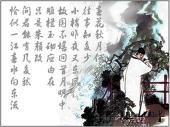
China Overview
- Population: 1.3 billion
- Currency: yuan
- Guinness World Records: most people painting each other's faces simultaneously in one location (13,413), largest bottle of cooking oil (containing 3212 litres), most couples hugging (3009 couples).
- Internet users: 135 million
- Milk beer: from Inner Mongolia, an alternative to the traditional mare's-milk wine.
- Squirrel fish: whole mandarin fish deep-fried and manipulated to resemble a squirrel.
- Number of chinese characters: over 56,000
Song Ci
Song Ci enjoys the same high reputation as Tang Poem, both of which are two peaks in Chinese culture and literature. Today Song Ci is collected in the anthology “Three hundred Ci from the Song Dynasty”. |
Ci is very different from poem. While poem can be read without minding the underlying melodies even if there were some underlying melodies, Ci must be seen as written songs. Most of the Ci do not even have a distinct title but are named after an original melody. Composers and writers used this melody to write a new poem that could be sung to the original famous melody or tune pattern (Ci Pai), a technique called contrafactury. There are more than | |
800 tune patterns known. This is the reason why we often see the same title for a Ci, like “Die Lian Hua” (“Butterflies love blossoms”), “Man Ting Fan” (“Scent fills the hall”) and “Yu Mei Ren” (“Lady Yu”). Ci emerged already during the Tang Dynasty in response to the popularity of foreign musical tunes imported from Inner Asia. Already the outer shape of the Ci is apparently different to the poem. In Ci the verses have different length, while in poem all verses have the same length of five or seven syllables. | |
All Topics about China
- General-China-Introduction
- C2-Chinese-History
- Chinese-Religions
- Chinese-Food-and-Drink
- Chinese-Literature
- Chinese-Nationality
- Chinese-Architecture
- Chinese-Arts-and-Crafts
- Chinese-Language-and-Education
- Chinese-Medicine
- Chinese-Transportation
- Chinese-Festival
- Chinese-Astrology-and-Zodiac
- Chinese-Calendar
- Chinese-Traditional-Sports-&-Activities
- Chinese-Martial-Arts
HOTMost Popular Topics
Climate in China
Because of its size, China has great climatic diversity. Generally, the best time to visit China is during spring and autumn.
Chinese-Language-and-Education
Chinese is the most commonly used language in China, and one of the most commonly used languages in the world.
Chinese-Festival
China has many traditional festivals, including the Spring Festival, the Lantern Festival, the Dragon Boat Festival.
Chinese Chinese-Astrology-and-Zodiac
In the Chinese zodiac, twelve animals are used to denote the year of a person's birth: rat, ox, tiger, rabbit, dragon.
History of China
China, one of the world's most ancient civilizations, has a recorded history of nearly 4,000 years..








